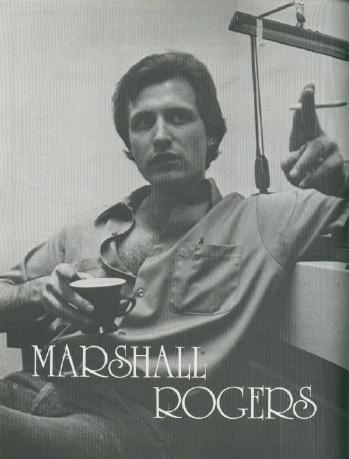
I'm going to tell you about magic. I'm supposed to be giving
you gory details about Marshall, but I don't know that many of them.
I know he was born January 22, 1950, around noon, in
Flushing, because I planned to do a horoscope on him once, but
since I've been too busy to get at that, I can't reveal his hidden
neuroses and lusts. I know that he looks like the Joker, which
can't hurt in an artist who made his entrance with The Batman.
And I know he enjoys a good time, preferably beginning
somewhere after midnight, and sometimes involving playing in
the freeway. Other than that, we'll have to examine the larger
picture. We'll have to imagine his magic.

Now, if you think Marshall blew your socks off when you first saw his work with the incomparable Terry Austin in Detective, my first look was an even bigger blast! Let me set the scene for you. I'd quit Marvel in April of '76, and had three things firmly in mind. One: I was getting out of comics. Two: before I went, I was going to pull out all the stops on the DC strips I'd asked for. And three: since most of DC's top artistic talent had been bled off by Marvel when Marvel had been climbing to the heights, and since I was the first to head for the Warner Building as Marvel came crashing back down the other side, I was going to need a miracle to get a decent artist for Detective. There was no regular artist on the strip, and the people who were available...well...
Luck seemed to rear its head for a while, when Walt Simonson and Al Milgrom agreed to do the honors - even though Walt had just decided to give most of his time to Marvel, and Al was perpetually overburdened with work. But the first two issues just didn't gel. Walt could do only the quickest of layouts, and Al's diligent inks couldn't take up all the slack. So, we were back where we started. No, further back, because those were big fish to have eliminated from the talent pool - and because I knew by then just how hot my vision of The Batman was going to be. I could see it all in my mind's eye - but I had had such visions before, only to have the final printed page look like it had been drawn with Professor X's foot. By 1976, people would read my stuff no matter who drew it, but comics is a hybrid medium, and if one half of the effect is botched, the lasting impression is botched, and there's no way around that.
I needed a miracle then, and that was just for openers. What I really needed was magic.
And then...
Marshall (and Terry) had tried their hand at Detective with Bob Rozakis's "Calculator" series, and the response that was just then coming in was positive and more. In the midst of those dark days, Julie Schwartz called me in California and asked if I'd work with these new guys. "Hell, yes!" I said. I knew nothing of Marshall's work beyond those first stories, but it looked as if he didn't play by the "rules," and I'll take somebody who's learning but trying over a burnt-out "star" any day. "Hell, yes!" I said. "Let's try."
Cut-
It's now February 1978. My wife Terry (no relation to Austin) and I are in our mountain villa in Mallorca. I'm upstairs writing my novel (once Best of Both Worlds, once Edge, now Max), immersed in lands and language far away from the full scripts I'd left in New York almost a year before. And then our village mailman rides his moped up the dirt path to our door to deliver a package from Julie. Inside, two copies each, are the last five issues of Marshall's and my Detective. Terry grabs one set, I take the other, and for the next several hours, the villa is silent save for scattered "Oh"s and "Ah"s.
It was magic.
And back in America, and in England and Canada and in all our ships at sea, you all had already felt the same.
Sometimes the gods just get together and smile down on things. Other times they frown. With comics in decline, the fact that Marshall was around at all was something just short of a miracle. The fact that he stepped right into a strip for which he had an exact and total feel is getting even closer. And the fact that he kept right on stepping, to Mister Miracle and others with DC, to head of the Comic Book Creator's Guild, and now to Don McGregor's new book all in only two years, is surely magic.
I said that I could envision what my strips should look like. Sometimes, when I saw the artist's vision, I was disappointed. Sometimes, I felt we'd met on equal ground. But only five times in my comics years did I feel that the artist had taken off from where I'd left him - and four of those times, the artist and I had worked side-by-side. But Marshall, without ever having met me at the time, gave me everything I asked for, and knew everything I didn't ask for.
Now it's July '79, and you've got some top guests at this con. Curt's been the artist on the comic character for just about ever. Big John Buscema's feel for the human figure is unsurpassed, and likely to remain so. But when you want that special midnight darkness, that chill of shadows and silence that can only come from between the penciled lines, then call on Mr. R. He's inside your mind somewhere already.
And he's magic.
-- Steve Englehart